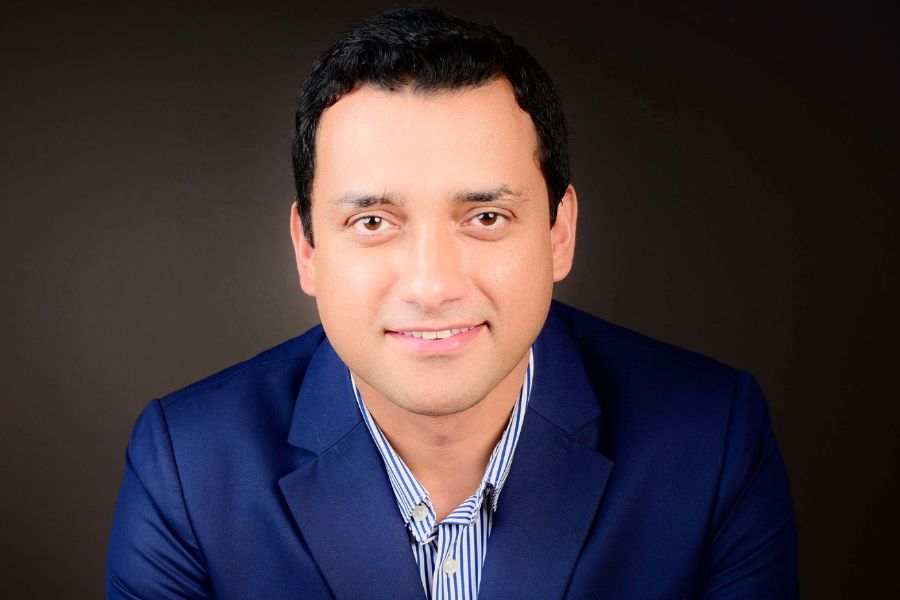India is embracing new-age technologies in AI Holograms, AR/VR, and beyond
Saurav Bhaik, CEO and Founder of Tagbin, provided exclusive insights to India Business and Trade (IBT) on the company’s path to achieving a successful fusion of technology and innovation, along with his perspectives on the future of cutting-edge technologies such as AR, VR, and AI.
Established in 2013, Tagbin is a pioneering tech-driven organization that seamlessly blends creativity with cutting-edge technology to craft immersive and enlightening experiences. Their portfolio boasts a rich tapestry of successful ventures, including contributions to prestigious government initiatives such as the Pradhanmantri Sangrahalaya, the Netaji Hologram Statue, the Pravasi Bharatiya Diwas Exhibition, the G20 Digital Experience Centre, and the Har Ghar Tiranga campaign. In the private sphere, they have collaborated with renowned brands like Coca-Cola, where they created the Coca-Cola Experience Centre, and Mercedes-Benz, where they developed the innovative Talking Car App.

IBT: Please provide a brief overview of Tagbin. Also, what inspired you to establish it and how did the idea for this unique blend of technology and creativity come about?
Saurav Bhaik: My journey started ten years ago when I graduated from IIT Roorkee. I have always been interested in two things: technology and creativity. However, it seemed that these two worlds didn’t coexist. I mean, a person could either be creative or delve into logical technology-related matters. When I graduated, it was during an era when new-age technologies like AR/VR were in vogue. So, we saw this as a new opportunity and ventured into immersive storytelling.
For the initial two to three years, there wasn’t much traction in India because these technologies were very new. Consequently, we began working from Dubai and Singapore, as these areas were already using these technologies for entertainment, events, and creating wow experiences for their customers in the retail and museum sectors. After two to three years, the Indian market also began to embrace these technologies. For the past four to five years, the Indian government has heavily utilized them in museums and communications for infotainment purposes.
Our belief is that the ultimate user experience can only be enhanced by incorporating these new-age technologies like AI holograms, AR/VR, and various other innovations. That’s how our journey began, and it has been a ten-year adventure that started with working with brands, then expanding abroad, and ultimately returning to India to collaborate with the government.
IBT: Can you share some specific examples of the immersive and multisensory spaces Tagbin has created using technologies like Augmented Reality, Virtual Reality, and Robotics for infotainment?
Saurav Bhaik: One of our top projects is the Pradhanmantri Sangrahalay, with our Prime Minister serving as a brand ambassador. Since its inauguration, the Prime Minister has mentioned this particular project in the media at least 10 times. In closed-circuit communications, he has encouraged people to visit it because it is one of a kind and among the best in the world. The majority of visitors to this museum are young people, and conveying history to them can be quite boring. Therefore, we’ve incorporated these innovative technologies to make it more engaging for them.
Let me provide you with an example. Within this museum, we offer a VR helicopter ride experience. It’s a helicopter setup with an immersive screen surrounding it. During this experience, visitors witness the journey of India’s development and get a glimpse of what India may look like in 2047. We take them to different places where India is working on new projects, such as the Sagar Mala project, the Rohtang tunnel, or the Dhulera Smart City. We show them the future so that they can grasp what India has in store for them.
Another unique experience we’ve created is an AI handwriting robot that generates personalized letters from their choice of Prime Minister. For instance, if someone selects Nehruji, we gather his messages to future generations from his letters and addresses to the nation. Using artificial intelligence, we replicate his handwriting. The letter begins with ‘Dear XYZ, this is my message to you,’ followed by a signature. This type of experience leaves a lasting impression because the Prime Minister is delivering a message in a unique way, combining novelty with silent but impactful content. We refer to this blend of technology and creativity as ‘infotainment,’ and it has resonated particularly well with our audience, especially the youth.
IBT: What is the potential of the AR/VR space in India and what are the most promising end-user segments? What is your vision for Tagbin in this domain?
Saurav Bhaik: We are currently in the era of Web 3.0. In Web 2.0, we witnessed major companies like Facebook, WhatsApp, and Google become giants in the industry. Now, everything is moving toward interactivity, much like the way we are communicating right now. What you see here is just a screen, but in Web 3.0, it will be a 3D world where both of us will feel as if you are right next to me. Therefore, Web 3.0 holds great promise.
Facebook has even changed its name to Meta, embracing the Web 3.0 vision because they see it as the future. Currently, we are in a very nascent stage. When we started in 2013, the hardware for VR, such as Google Cardboard and Oculus One, was not very advanced. However, now, with products like Apple’s Vision Pro and Oculus Quest, the quality of hardware has improved significantly, creating a much more realistic experience, as if we are truly in a 3D world.
In the future, this technology will have immense potential, especially in training and defence scenarios. We can create simulations where you are in the middle of a war zone, undergoing aviation training, or learning how to operate a metro system. Training will become a crucial application. Games will become incredibly immersive. Currently, we experience games on a screen, but in the future, you will be an integral part of the game world.
In the metaverse, you can even go shopping in a 3D mall. Thus, there are numerous applications, ranging from training and entertainment to education. Web 3.0 and VR have a promising future in the next four to five years.
IBT: What future trends or technologies do you see as particularly exciting and potentially impactful for Tagbin’s work in spatial transformation, experiential innovation, and tech-driven outreach?
Saurav Bhaik: We specialize in creating the ‘wow factor,’ which is akin to performing magic for individuals, leaving them wondering how it all happens. Typically, any technology requires time to reach stability. VR, for instance, was first introduced way back in 1968, and it took a remarkable 60 years to reach its current state. Therefore, we can’t expect any technology to be launched and immediately available for use. There’s a natural maturity curve that every technology must go through.
Our approach involves blending these technologies to craft new and innovative use cases. For instance, for the G20 summit, we developed a unique AI hologram that greets various heads of state and delegates. This project incorporates hologram technology and artificial intelligence. The AI can address individuals by their names, such as saying, ‘Welcome, Aashima.’ If someone is from France, the AI will greet them in their language. We employ facial recognition to identify the person and their name. Simultaneously, we use voice cloning, and there’s an avatar that materializes as a hologram. By amalgamating two or three technologies, we create novelty, and it’s this uniqueness that captures people’s interest.
In the future, we will continue to focus on using these technologies creatively to develop blends that appear natural and captivating.
IBT: How does Tagbin balance innovation and sustainability in its projects, especially considering the rapid advancements in technology and the need for environmental responsibility?
Saurav Bhaik: Sustainability is our priority because I am looking forward to Mr. Narendra Modi’s vision for 2070 when India aims to achieve Net Zero emissions. We have built India’s first Net Zero Museum, which operates without water or electricity connections. Everything is powered by solar energy. Additionally, we have implemented radiant cooling, a system that consumes almost 90 percent less electricity compared to traditional methods. In another project for Himachal tourism, we’ve introduced a VR bus, and our natural choice for that was an electric vehicle. We are committed to supporting India’s goal of achieving Net Zero emissions wherever and whenever possible.
IBT: What advice would you give to aspiring entrepreneurs looking to venture into the intersection of technology and creativity in the experiential industry?
Saurav Bhaik: We operate in the creative tech space, and the most important piece of advice I can offer to those interested in entering this field is that you must navigate between two distinct groups of individuals. Creative minds are often driven by emotions, and deadlines may not be a significant concern for them; they pursue perfection. On the other hand, technology professionals tend to be binary thinkers, leaning toward ‘zero or one,’ ‘right or wrong.’
To succeed in this field, you must find a way to harmoniously unite these two groups. The real magic in our industry occurs at the intersection of these two mindsets. When technology and creativity converge, and both perspectives are given equal weight, remarkable things happen. If the balance tips too far in one direction, the outcome may not be as exceptional.
In our line of work, where the goal is to create a memorable experience, achieving this balance is paramount. The experience we deliver needs to be both functional and awe-inspiring, making it essential to harness the synergy between technology and creativity.
For entrepreneurs, collaborating with engineers and creative individuals, and encouraging them to reach a consensus, can be challenging. However, this is something we’ve excelled at over the past ten years. People from diverse backgrounds come together, sit down, and respect each other’s ideas. The end result is a well-balanced and exceptional product or experience.

Saurav Bhaik is the CEO of Tagbin, a leading tech-experiential company that specializes in creating unique and unforgettable experiences. As an IIT Roorkee alumni, Saurav is known for his groundbreaking ideas and passion for creating world-changing, high-impact projects such as Pradhanmantri Sangrahalaya, hologram statue of Netaji Subhas Chandra Bose, Temple 360, Digital Exhibition at 17th Pravasi Bharatiya Divas, and more. With over a decade of experience in diverse fields, including space design, outreach campaigns, and groundbreaking experiential technology, Saurav is committed to pushing the boundaries of what’s possible and striving for excellence in everything he does.













Leave a comment